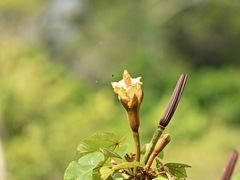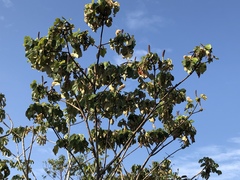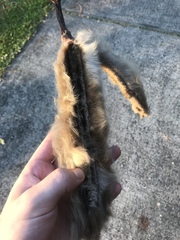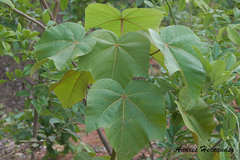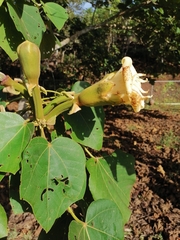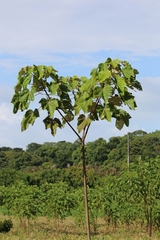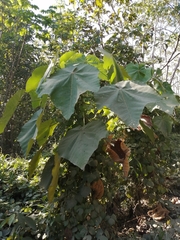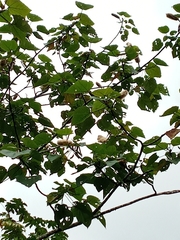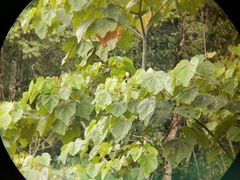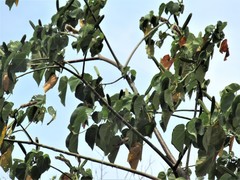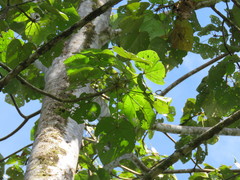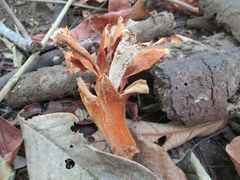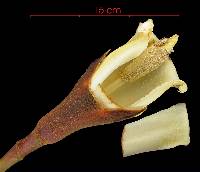

|
|
|
|
Family: Bombacaceae
West Indian Balsa, more... (es: balsa, Balso, lano)
[Ochroma bicolor Rowlee, moreOchroma limonense Rowlee, Ochroma limonensis Rowlee, Ochroma velutina Rowlee] |
Description: A medium-sized tree of roadsides, usually branching near the ground, with a wide, flat crown. Leaves are large and heart-shaped, usually weakly lobed, that is with corners on either side of the leaf. There are 3-5 prominent veins arising from the leaf base, and the underside of the leaf is whitish. Reproduction: The balsa can be partly deciduous during the second half of the dry season or the beginning of the wet season, although leaves grow back quickly so trees are not usually completely leafless. Flowers are very large, to 20 cm across, and white, produced in December and January. Many birds, bats, and even kinkajous and olingos (arboreal, noctural mammals) visit the flowers for nectar. Fruits mature from February into the beginning of the wet season, are are long capsules that open to reveal tiny seeds covered in hairs that carry seeds in the wind. Distribution: An abundant roadside species throughout the Canal area and most parts of Central and South America. Scarce in the forest, with juveniles only appearing in large clearings. Similar Species: The large, heart-shaped leaves, weakly lobed, are distinctive. The other native species with similar leaves is the cuipo, LK cavapl Cavanillesia platanifolia, LK2 which is much less common along roads, has a straight trunk unbranched for most of its length, and generally has smaller leaves. Other species with heart-shaped leaves do not have the lobes (corners) of the balsa. See also the non-native LK tectgr teak, LK2 which has leaves quite like those of the balsa, and does occur pretty commonly along roadsides of the Canal area. Uses: This is the balsa of model-airplane fame, with extremely light, soft wood. It is also used for making rafts (hence the name balsa, Spanish for raft). The seed's fibers are used for making cushions or life vests. Descripción: Árbol de 10 a 30 m de alto. Copa amplia con ramas gruesas y extendidas. Tronco recto y cilíndrico, a veces con raíces tablares pequeñas en la base. Corteza exterior negra o gris. Ramitas terminales gruesas y cubiertas de pelos ferruginosos. Hojas simples y alternas, lobuladas, con 3-5 lóbulos, muy variables en tamaño, generalmente miden de 9-40 x 8-35 cm, ovadas, con ápice agudo y base cordada. Las hojas son verdes en el haz y cremas o marrón por el envés. Estípulas foliares, persistentes en los ápices de las ramitas. Pecíolo de 5-10 cm de largo. Flores blancas o amarillentas, grandes y en forma de ‘embudo’. Frutos en cápsulas alargadas, de 10-25 cm de largo, verdes y con surcos longitudinales, tornándose negros y dehiscentes al madurar. Cuando los frutos abren forman una capa algodonosa que parece la ‘pata de un conejo’ y en la cual se encuentran envueltas las semillas. Datos Ecológicos: La especie crece a bajas y medianas elevaciones, en lugares secos, húmedos o muy húmedos. Común a orillas de caminos, carreteras y bosques secundarios de todo el país. También se encuentra en los márgenes de los ríos, especialmente en tierra humífera con alto contenido de abono orgánico y arena. Deja caer parcialmente sus hojas alrededor de junio y agosto, pero las repone rápidamente. Antes de caer las hojas se tornan de color anaranjado en la copa del árbol. Florece y fructifica de noviembre a julio. Las flores son visitadas por murciélagos. Las semillas son dispersadas por el viento. Especies Parecidas: A menudo se confunde con LK crotdr Croton draco LK2 y LK crotsm Croton smithianus LK2 , pero Croton tiene savia roja y glándulas en la base de la hoja, lo cual no ocurre en Ochroma. Usos: La madera es liviana, empleada en el aislamiento térmico, fónico y vibratorio, en la construcción de balsas, boyas, embalajes especiales, maquetas de aviones y de autos. Los pelos algodonosos del fruto se utilizan para fabricar colchones, salvavidas y almohadas. El balso es un árbol de crecimiento rápido empleado para rehabilitar suelos degradados, también como planta ornamental por sus hojas y flores vistosas. Tree, usually less than 12 m tall but to 30 m where persisting in the older forest, 30-180 cm dbh, sometimes buttressed; wood very lightweight; branchlets, pedicels, lower blade surfaces, petioles, and exposed parts of calyces with a dense layer of brown, stellate, tufted trichomes. Leaves simple, clustered at ends of branchlets; stipules ovate, to 1.5 cm long; petioles thick, 3-40 cm long; blades ovate, acuminate, cordate, 9-40 cm long, 8-35 cm wide, entire to shallowly 3-5-lobed, glabrous above in age, pale below; palmate veins at base 7 (9). Flowers not precocious, leathery, with a pleasant aroma when young; pedicels to 12.5 cm long and 1.5 cm broad; calyx lobes stiffly coriaceous, unequal in shape, to 5.5 cm long, sericeous-villous inside; petals obovate-spatulate, to 15 cm long and 5 cm wide, whitish; staminal column 10-12 cm long, the antheriferous part 5-6 cm long, enlarged at anthesis; pollen with a foul odor, at least in age, evenly distributed over column surface; anthers sessile, longitudinally dehiscent, the theca 1; style completely enveloped by stamens in bud, about as long as stamens at anthesis; stigma stout, spirally 5-sulcate. Capsules long, narrow, to 25 cm long and 2.5 cm diam, black and glabrous outside, densely lanate inside, the valves 5; seeds many, small, ca 5 mm long. Croat 4637, 7214. Common along the margin of the lake or in disturbed areas, rare in the older forest where it is a large tree. Flowers from August to May, mostly from November to March. The fruits mature from February to August. Leaves fall around June and are replaced in August. The flowers open at night, sometimes persisting to the following day. At anthesis the anthers, which are somewhat spirally arranged around the style, are unfurled and spread broadly. By the following day they are again closely twisted around the stigma. White-faced monkeys have been seen in the daytime poking their faces into the flower, possibly searching for insects, and their faces become liberally covered with pollen. They probably do not regularly effect pollination because the stigma is then covered, but the flowers may be visited by nocturnal mammals in the same way. Birds often cut holes near the base to obtain nectar. Seeds are principally wind dispersed but probably also water dispersed, made buoyant by the brownish kapok fibers within which they are enveloped. Native to the New World; pantropical in cultivation. In Panama, known from tropical moist forest in the Canal Zone, Bocas del Toro, Colón, Veraguas, Los Santos, Panama, and Darién, from tropical dry forest in Panama (Taboga Island), from premontane moist forest in the Canal Zone and Panama, from premontane wet forest in Chiriqui, and from tropical wet forest in Veraguas (Atlantic slope). See Fig. 370. Bocas Species Database Characteristics: Tree that reaches 10 to 30 m in height. Its flowers are white or yellowish, large sized and in shaped like a cone. Fruits are in long capsuls and turn black when ripe. |
|
|
|







